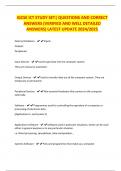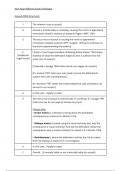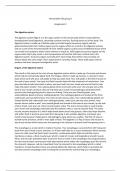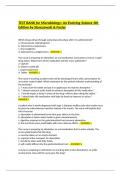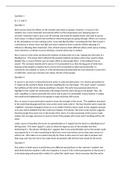INTERNATIONAL MARKETING
01 PRACTICAL INFORMATION AND INTRODUCTION
- The application of marketing principles to more than one country
Find international customer needs and satisfy them better than the competition
- 5 decisions:
1. Whether to internationalize
2. What markets to enter
3. Market entry strategies
4. Designing the International Marketing Plan (IMP)
5. Implementing & coordinating the IMP
1. Internationalization vs Globalization
1. Globalization: the change in the world economy to a more interdependent system
The trend of firms buying, developing, producing and selling product/services in most
countries and regions of the world
Global economic integration of many formerly national economies into one global
economy
2. Internationalization: the activity of firms on an international scale and the resulting
impact of their activities.
International, means between or among nations
International can be limited to a region or a few countries
A response to Globalization.
- Global marketing
Finding and satisfying global customer needs
Coordinating marketing activities
Depends on the global maturity. This world view of a firm’s business activities can be
described with the “EPRG framework”
Finding global customer needs and satisfying Centralizatio
n Adaptation
global customer needs better than the
competition.
Standardizati
Delegation
on
, EPRG framework: ethnocentric, polycentric, regio-centric and geocentric.
1. Ethnocentric:
o Home country is ‘superior’
o its needs most relevant
o highly centralized decision-making
o product is a copy-paste of home
o organization & technology same as in home country
+ cheaper, high degree of control, one-way communication
- no full exploitation of opportunities worldwide, inefficient: decisionmakers need to travel a
lot, no opportunity to learn from other cultures
2. Polycentric:
o each country is unique
o decision-making: host country orientation
o highly decentralized
o products & marketing: country-by-country: different conditions for production and
marketing in different locations
o each national market is distinctive
o focus on differences between home country & foreign country
o marketing strategy – localization / adaption
o companies’ basic objective – public acceptance
o will try to adapt to different conditions in order to maximize profits in each location
+ better understanding of local needs, better exploitation of local market potential,
easier targeting with local teams, maximize profits in each location with specific targets
- no economies of Scale, high cost of local responsive marketing mix, lack of coordination
& control, no knowledge transfer between locations
3. Regio-centric:
o The world consist of regions
o These regions will be based on similarities
o Operational strategies formulated based on entire region rather than individual
countries.
o Reasons: easier interaction, some sensitivity towards local, transitional step
4. Geocentric:
o The world is one common market
o Develop global product concepts without adaption to the product, but depends on
the industry
o HQ & subsidiaries collaborate closely
, o Not possible in FMCG, while easier in technology sector
o Downsides: no specific targeting, trend of deglobalization
2. Globalization vs localization
1. Globalization:
Global integration
Recognizing the similarities between international markets and integrating them into the
overall global strategy
2. Localization:
Market responsiveness
Responding to each market’s wants and needs
Globalization + Localization = glocalization (think global, act local)
, 02 NTERNAL ANALYSIS
1. Global Marketing & Management Style (LSE vs SME)
- Comparison between LSE’s and SME’s
- Formation of strategy/decision making processes (Management Stule LSE’s and Stategic drift)
01 PRACTICAL INFORMATION AND INTRODUCTION
- The application of marketing principles to more than one country
Find international customer needs and satisfy them better than the competition
- 5 decisions:
1. Whether to internationalize
2. What markets to enter
3. Market entry strategies
4. Designing the International Marketing Plan (IMP)
5. Implementing & coordinating the IMP
1. Internationalization vs Globalization
1. Globalization: the change in the world economy to a more interdependent system
The trend of firms buying, developing, producing and selling product/services in most
countries and regions of the world
Global economic integration of many formerly national economies into one global
economy
2. Internationalization: the activity of firms on an international scale and the resulting
impact of their activities.
International, means between or among nations
International can be limited to a region or a few countries
A response to Globalization.
- Global marketing
Finding and satisfying global customer needs
Coordinating marketing activities
Depends on the global maturity. This world view of a firm’s business activities can be
described with the “EPRG framework”
Finding global customer needs and satisfying Centralizatio
n Adaptation
global customer needs better than the
competition.
Standardizati
Delegation
on
, EPRG framework: ethnocentric, polycentric, regio-centric and geocentric.
1. Ethnocentric:
o Home country is ‘superior’
o its needs most relevant
o highly centralized decision-making
o product is a copy-paste of home
o organization & technology same as in home country
+ cheaper, high degree of control, one-way communication
- no full exploitation of opportunities worldwide, inefficient: decisionmakers need to travel a
lot, no opportunity to learn from other cultures
2. Polycentric:
o each country is unique
o decision-making: host country orientation
o highly decentralized
o products & marketing: country-by-country: different conditions for production and
marketing in different locations
o each national market is distinctive
o focus on differences between home country & foreign country
o marketing strategy – localization / adaption
o companies’ basic objective – public acceptance
o will try to adapt to different conditions in order to maximize profits in each location
+ better understanding of local needs, better exploitation of local market potential,
easier targeting with local teams, maximize profits in each location with specific targets
- no economies of Scale, high cost of local responsive marketing mix, lack of coordination
& control, no knowledge transfer between locations
3. Regio-centric:
o The world consist of regions
o These regions will be based on similarities
o Operational strategies formulated based on entire region rather than individual
countries.
o Reasons: easier interaction, some sensitivity towards local, transitional step
4. Geocentric:
o The world is one common market
o Develop global product concepts without adaption to the product, but depends on
the industry
o HQ & subsidiaries collaborate closely
, o Not possible in FMCG, while easier in technology sector
o Downsides: no specific targeting, trend of deglobalization
2. Globalization vs localization
1. Globalization:
Global integration
Recognizing the similarities between international markets and integrating them into the
overall global strategy
2. Localization:
Market responsiveness
Responding to each market’s wants and needs
Globalization + Localization = glocalization (think global, act local)
, 02 NTERNAL ANALYSIS
1. Global Marketing & Management Style (LSE vs SME)
- Comparison between LSE’s and SME’s
- Formation of strategy/decision making processes (Management Stule LSE’s and Stategic drift)

